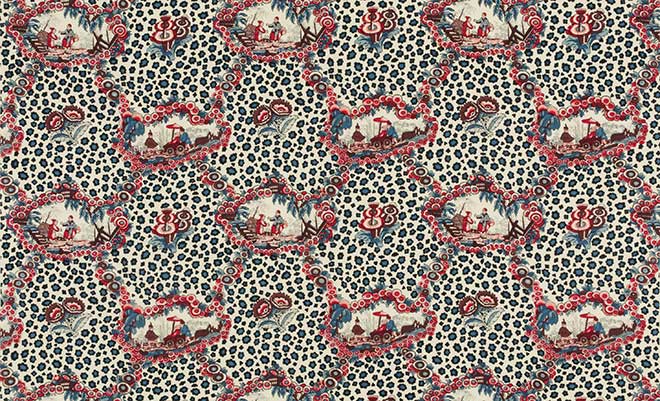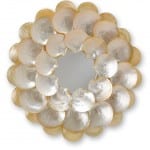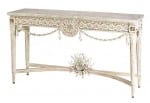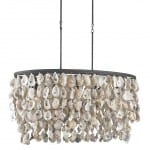come to terms with: toile de jouy
From the beginning of time, our world and economy has been driven by the latest technology, which includes the fashion and design fields.
In the early 16th century, cotton fabric from India was all the rage and large quantities were imported by France. This new fabric was used for clothing, curtains, wall coverings and upholstery. The French, being French, became rather nervous, and in 1686 the secretary of trade under Louis XIV convinced His Highness to ban the importation of all fabrics made in India. The French then focused on the sale and export of their own silks, wools and other cloths. In 1759 the ban was lifted, as it was increasingly difficult to enforce.
Timing is everything. In 1758, at the young, energetic age of 20, Germanborn Christophe-Philippe Oberkampf moved to Paris. He came from a long line of cloth dyers. In a year’s time, he formed a partnership and began printing on cotton in Paris near the Île de France.
Locating their factory on the river La Bièvre (the beaver) in Jouy-en-Josas, Oberkampf and his partner understood that the chemical makeup of the waters was perfect for washing their cloth. In 1760 their first fabric was presented. They used woodblock printing until they acquired a special printing press in 1770. Copperplate technology, which they were the first in France to use, broadened their ability to create larger and more complicated patterns. In 1783 the popular artist and painter Jean-Baptiste Huet became head designer for their factory and was bestowed the ‘Manufacture Royale’ designation by Louis XVI.
The designs ranged from bucolic to historical events and figures in the familiar scenes typical of toile. A major player in the economy, Oberkampf and his partner employed some 1,322 people by the late 18th century. With the major clout they had, they also enlisted famous artists Fragonard and Boucher to create designs for them. More than 30,000 designs came out of the Jouy factory under their leadership.
Today, interior designer Sheila Bridges and Beastie Boys member Mike Diamond also create their own versions of toile for the market, which only proves the staying power of good design.
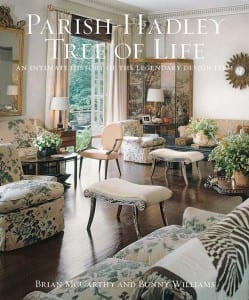 design library: parish hadley tree of life
design library: parish hadley tree of life
I credit my earliest design training to Architectural Digest, which I’ve been reading since age 12. I would examine each photo and read each word to learn all I could about the magic of creating beautiful interiors, as well as the lingo that goes along with it. Often these timeless, and dare I say ‘perfect,’ spaces were designed by the firm Parish Hadley. Sister Parish and Albert Hadley joined forces to create the finest decorating firm in the United States and to exert influence globally.
The just-released tome, Parish Hadley Tree of Life, an Intimate History of the Legendary Design Firm, is a brilliant tribute to Sister and Albert by those who knew them best, their employees. Important names in the world of interior design who contributed to this book include David Easton, Bunny Williams, Thomas Jayne, Mariette Himes Gomez and Thom Filicia, to name just a few P-H alums. There are 30 success stories shared here, all giving high praise to their experience with the eponymous firm and how it shaped their future businesses.
This book is a great primer for any design professional or do-it-yourselfer who wants to learn some of the tried-and-true rules of interior design, as well as how to break them and make a space your own.
The way interior design is executed as a profession has changed with the internet and big box stores. Sadly, the civility that so characterized this field at its highest point is now less and less a part of a business that emphasized society and white-glove service in Sister’s and Albert’s time. However, the principles needed to create a truly fine and timeless interior have remained the same. This book proves that point.
design redux: sea shells
Sally no longer sells seashells only by the seashore—she has gone retail! One of the latest trends is all things ocean-related, in particular, seashells. How often do you, or people you know, pick up seashells during trips near the ocean? I do.
They have been gracing and accenting the interiors of homes since pre-Victorian days. Families proudly displayed them as mementos of travel to faraway, oceanside sites.
Sometimes shells would be used in creations for the home, like when children collect them and glue them to boxes or picture frames to create a craft item the whole family could enjoy (or not!). And what child hasn’t held a conch shell up to their ear to hear the ocean?
Today there is a plethora of options for those who admire shells. Why not consider using them in your lighting, furniture or wall accessory? A little can certainly go a long way, but selecting just the right accent piece to ‘mix it up’ a bit can really make a room sing!
The versatile colors—milky whites, buttery creams, the faintest corals, greens and blues—come from nature and will fit into any scheme you can imagine. The fact that shells don’t align with any particular period also can make them the perfect solution to fill that void you are perplexed by.
Show Sally something special with your seashells!





